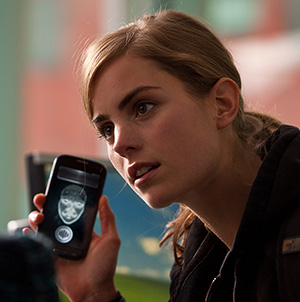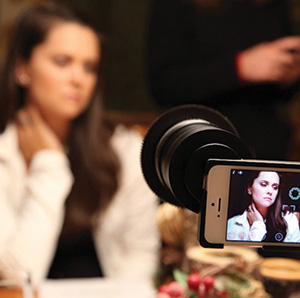

Dinner and wine with friends. Snow—and sledding. Stark, wide-angle winter landscapes. As Uneasy Lies the Mind opens, it’s a string of familiar moments: snapshots that could have turned up on Facebook, posted by a friend who’s in Tahoe for a few days. The saturated colors, darkened edges of frames and washes of overly warm or cold tones blend into a blown-out, lo-fi look that confers a patina of instant nostalgia, like Instagram shots come to life. And that’s not far from the truth.
Though Instagram had nothing to do with the film, director Ricky Fosheim shot the thriller using an iPhone 5 and an app called FiLMiC Pro 2.
Emphasizing the small and portable future of filmmaking, two films at Cinequest this year demonstrate the possibilities of iPhone and Android as tools to create cinema. Uneasy Lies the Mind implements the smartphone as a new way to shoot a movie; the Dutch thriller APP employs the phone as a new way to view a movie.
Los Angeles-based filmmaker Fosheim says his Uneasy Lies the Mind, making its world premiere at Cinequest, is the first fictional feature film to be made entirely on an iPhone 5—a film shot with a Hong Kong-made Turtleback 35mm lens adapter meant to use the visual limitations and glitches in the medium.
Fosheim aims to create the vision of a traumatized man starting to lose his sanity.
“I knew that it was going to be kinda grainy and handheld and very fragmented, distorted. It wasn’t supposed to be a crisp and clean image,” Fosheim says.
Mike Rabehl, programming director of Cinequest, comments, “We have shown short films shot on phones before, of course, but never a feature shot entirely on the iPhone. This is the first I know of that utilizes the phone as a true camera.”
Fosheim has written about how careful he was to test this rigged-up iPhone against other popular digital cameras, such as the Red Epic and the Canon5D Markill.
The director notes his influence by Janusz Kaminski’s work in Saving Private Ryan. The Polish cinematographer brought a ticky, thousand-yard stare to the picture by gutting his 35mm camera of its pressure plate and registration pins that keep the film in place as it passes by the iris. The result: Kaminski emulated the slightly unsteady images caught by the 3-lens, 16mm wind-up Bolex movie cameras used during World War II by newsreel camera operators. (The look has become a clichE; it’s turned up in war movie after war movie since.)
While Fosheim worked with the visual limitations and glitches in the medium he chose, and while Turtleback makes small portable lenses in a wheel for cameras, the more pricy Turtleback lenses can turn what once were flat, electronic-snapshot photos commonly got on cellphones into emulations of high end cameras. Introduced as recently as the 2012 MacWorld, clip on lenses are one way to modify the eye of the iPhone; other kits have optional camera handles that can house spare lenses. Hard-shell cases allow lenses to be screwed into place like a monocle; they include screw-in apertures for tripods to keep the camera still… and likely to keep the most ungainly hybrids–long professional telephoto lenses yoked to cigarette-pack sized cellphones—from toppling over face-first.
The distorted look reinforces a surreal quality in Uneasy Lies the Mind as the story emerges: friends gather at a mountain cabin to celebrate Peter’s (Jonas Fisch) birthday. An undercurrent of apprehension (over Peter’s wife’s pregnancy, another couple’s marital tension) devolves into jealous confrontations and fragmented conversations that seem increasingly distant from reality.
The phone’s small size and light weight allowed for claustrophobic closeups and shots taken from tight corners or from right within the action, where a more cumbersome traditional camera rig couldn’t go. However, the phone proved less hardy than a camera, as well. Working on an icy mountain—the film was shot at Mammoth Lake during a blizzard—the director notes the frequent freezing up of the iPhone due to low temperatures.
Fosheim emphasizes that despite the availability of higher-end equipment, he felt that the iPhone best conveyed the look he wanted—it was aesthetics that drove his choice of camera. “Even when you’d plug the iPhone into the charger while you were filming, you’d get these weird electrical pulses, once every three or four seconds, there will be one frame kind of flashing a little brighter. It’s very subtle. What better way to represent a dying man’s memory than to have these electrical pulses and these dirty, grainy, vignetted shots. We’d keep dirt and hair on the lenses so it would be kind of nasty looking.”
Fosheim aims to recall the first generation of digital filmmakers, who also got an aesthetic by pushing the limits of their hardware: the smeary, goldenrod-colored nimbuses in Harmony Korine’s digital-taped camera work, the way the too-bright candles glow like cathode-ray flare in early Dogme films. And two of the last really frightening horror films, David Lynch’s Inland Empire and The Blair Witch Project, depended on the fear of things you couldn’t quite see in the grey-black dark.
A Second Look
Unseen forces of a different nature fuel the scares in Dutch director Bobby Boermans’ APP, a thriller about IRIS, a malevolent app that takes over a woman’s life. (IRIS is SIRI spelled backwards.)
Touted as the first movie made for the “second screen,” APP allows audiences to use their phones as part of the film. Viewers download an app—a benign version of IRIS—at the movie’s start to receive synced texts and additional content on their phones as they watch the movie in the theater. Boermans partnered with media company 2CFilm to produce the IRIS app, which supplements the action on the screen with messages or short clips on viewers’ devices. If characters text each other, audiences will see the conversation on their phones.
“Most of us general users have no idea where our personal data goes after we enter it on a computer, tablet or smartphone É.” Boermans says. “This scary thought led to the idea of developing an exciting story about a ruthless smartphone app. … At the same time, I really wanted to make a film that especially would appeal to a younger audience. And since most kids these days are glued to their smartphones (yes, let’s face it, even inside a movie theater), it became pretty obvious to me that we also had to develop an actual app, complementary to the movie itself. It just felt like second nature.”
In order to synchronize viewers’ phones with the action on the big screen, APP repurposes technology originally developed to combat illegal downloads. The film industry claims to be losing millions of dollars to piracy, since people with cellphones are able to dupe and download to bit-torrent sites acceptably watchable copies of the latest releases. Several cinema distribution labs, including Kodak, Philips and Deluxe Labs, have devised different ways to earmark prints with coded, barely visible—but visible—dots. APP uses SyncNow, digital audio watermarking software, which is embedded in the movie’s soundtrack. These watermarks, which use the full audio spectrum but are inaudible to humans, send signals to the movie app through the speakers on viewers’ phones. The app is then prompted to show messages and additional content.
Creating a film for dual screens—where in some cases audiences on their phones will learn key pieces of information before the film’s protagonist does, while also structuring APP so that it makes sense for viewers not using their phones—proved a challenge for editing the film.
“You have two storylines and you have to determine what you’re going to show on which screen,” Boermans says.
Another unusual consideration: accounting for the three seconds on average needed for audiences to switch focus between the movie screen and phone screens. A few scenes had to be slightly extended so that audiences could make the transition without missing any crucial plot points.
APP will make its U.S. debut at Cinequest, but has already been released in some European countries and Hong Kong. Boermans says audiences, particularly younger viewers, have embraced the second screen element.
“Everybody has their phone with them. If one person in the theater has that reaction that they want to try it, then other people want to go with it. It’s socially acceptable, the fact that there’s going to be phones in the theater because it’s part of the film,” Boermans
Despite the fact that APP was made with a younger generation of viewers in mind, Boermans doesn’t necessarily see second screen as a guaranteed successor to conventional moviemaking.
“I do think the future of cinema is something that’s going to evolve in certain ways—second screens, moving chairs, snow effects—cinemas have to innovate a little bit in making the experience more immersive and more enjoyable É Second screen can be one of those things. All these technology tools can help the story, the excitement and the entertainment factor of the movie. I think that’s where the future is going to go. Every city is going to have 5D movie theaters,” he says.
Calling Ahead
Neither Fosheim nor Boermans could have achieved their respective visions without the portability of mobile devices. And phones will evolve to become even more mobile, says Martin Cooper, the wireless communications pioneer who’s known as the father of the cell phone. (Cinequest celebrates Cooper’s work with a Maverick Innovator Award this year.)
“The operative thing is that cellphones are now part of our lives,” he says.
Cooper envisions a future, possibly in just one more generation, in which phones might be worn constantly, embedded under the skin. He sees the boon of ever-increasing mobility in a broader scope, as enabling still greater communication.
“The idea of making collaboration more efficient, more effective—that will affect everything we do. [Moviemaking] is another business where collaboration is crucial; the whole idea of hierarchal organizations, that’s going to start disappearing. Certainly that’s true of moviemaking, there’s still the director, still the producer, when I see the credits on it after I watch a movie. It takes thousands of people. The idea to have a collaboration going on and lots of those people are going to be part of the process. We have this naive thing where there’s one idea person. The thing that is true is that a lot of people never get to offer their input.”
Perhaps it’s no accident that both of the films at Cinequest that pioneer the use of mobile technology, albeit in vastly different ways, are thrillers, each drawing on the fact of cellphones’ integral roles in daily life. Phones have become trusted digital assistants that not only go most everywhere their owners do, but also enable personal interactions: instant contact with family and friends.
Uneasy Lies the Mind uses that proximity—both physical and figurative—to capture what we might see in our mind’s eye. APP plays on that same nearness to speculate on a worst-case scenario of personal technology turned against us—while at the same time enlisting device-toting audiences to make it happen.
Both Fosheim and Boermans say that they chose cellphones simply as tools in the service of telling specific stories. Though current mobile technology may not supplant traditional means of moviemaking, both directors’ films suggest the evolution of the phone in filmmaking beyond a novelty for its own sake.
“I don’t think [APP] is going to be the defining answer of what the future is going to be, but it’s a small part. There will be more test cases and more experiments—people are going to see what they can do with this technology,” Boermans says. “As long as it serves the story, every tool is permitted and allowed.”
‘Uneasy Lies the Mind’ shows Sat, 3/8, 9pm (C12); Sun, 3/9, 2:30pm (C12); Fri, 3/14, 2:15pm (C12)
‘APP’ shows Fri, 3/14, midnight (C12); Sat, 3/15, 4:3pm (C12)



